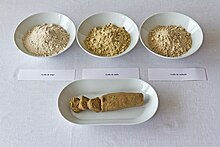Gofio
Gofio is a product obtained by grinding roasted grain with or without the addition of sea salt. Occasionally, the Gofio also contains pulses, which undergo the same treatment as the grain. Gofio canario 'Gofio from the Canary Islands' is a protected geographical indication (PGI) in the European Union . PGI.
The same product is a traditional staple food in Tibet under the name Tsampa .
origin
Gofio is the most important vegetable food of the old Canarians , the first inhabitants of the Canary Islands . The starting products were roasted in clay jugs , ground in hand mills and eaten mixed with goat's milk , goat's cheese or fat. Even after the islands were conquered by the Kingdom of Castile in the 15th century, Gofio was an important part of the diet, especially for the rural population.
Raw materials
Traditionally, Gofio was made from barley . The roasted grains were processed as whole grains with the skins. Wheat and legumes were used in smaller quantities . In times when grain was scarce, the seeds of trees and ferns, as well as various roots, served as substitutes. Today in the Canary Islands 55% of the Gofios is made from maize, 19% from wheat, 14% from a mixture of wheat and maize and 12% from other grain mixtures. Barley plays a certain role on the island of Fuerteventura . Overall, the processed quantities of chickpeas, rye, oats, millet and rice remain statistically below 1%. Except for wheat, 42% of which is imported from France, most of the raw materials come from the Canary Islands or the Spanish peninsula.
Manufacturing
Since the 16th century there have been a large number of windmills and water mills in the Canary Islands, in which mainly Gofio was produced. The mills were usually run by the local, aristocratic landowners because, unlike independent millers or tenants, they did not have to pay any taxes. In 2013 there were 40 gofio mills in the Canary Islands. 107 people worked in the mills, 40% of whom were mill owners and their family members. "The presence of the master miller who, in the mills of Gofio Canario, determines the end of the respective process using skills that have been passed on from generation to generation, is the decisive characteristic in the production of Gofio Canario ."
use
While Gofio was long regarded as poor people's food, which could easily be taken with you when you were working in the field during breaks, interest has increased due to a renaissance of the Canarian past as well as nutritional knowledge. Cereal grains contain around 12% water, a large part of which is evaporated during the roasting process. Other ingredients are around 11% protein, 2% fat, 2.5% fiber and 70% starch. All cereals contain a high proportion of minerals and vitamins E, B1 and B2. The energy content of the Gofio is over 300 calories (approx. 1250 joules) per 100 grams. Some mills also sell energy bars e.g. B. made from corn and wheat gofio, honey, almonds, peanuts, raisins, lemon juice and cinnamon. The ingredients are just kneaded together.
In gastronomy today, Gofio is offered in two versions. On the one hand in the more traditional way than dough, where Gofio z. B. is kneaded with meat or vegetable broth, herbs and onions or as a sweet variant z. B. with honey, ground almonds and raisins.
Individual evidence
- ↑ a b Publication of an application for registration in accordance with Article 50 (2) (a) of Regulation (EU) No. 1151/2012 of the European Parliament and of the Council on quality regulations for agricultural products and food , accessed on September 14, 2016
- ↑ Implementing Regulation (EU) No. 128/2014 of the Commission of February 5, 2014 for the entry of a name in the register of protected designations of origin and protected geographical indications Gofio Canario (PGI) , accessed on September 14, 2016
- ↑ Diploma thesis Production of baked goods from a naked barley variety taking into account the functional ingredients at the University of Vienna
- ^ Antonio M. Macías Hernández: La “Economía” de los primeros isleños . In: Antonio de Béthencourt Massieu (ed.): Historia de Canarias . Cabildo Insular de Gran Canaria, Las Palmas de Gran Canaria 1995, ISBN 84-8103-056-2 , p. 55 (Spanish).
- ↑ Instituto Canario de Calidad Agroalimentaria (ed.): Estudio sobre la producción del sector del gofio en Canarias . Gobierno de Canarias, Santa Cruz de Tenerife, Las Palmas de Gran Canaria 2013, p. 13 ff . (Spanish, gobcan.es [accessed September 14, 2016]).
- ↑ Instituto Canario de Calidad Agroalimentaria (ed.): Estudio sobre la producción del sector del gofio en Canarias . Gobierno de Canarias, Santa Cruz de Tenerife, Las Palmas de Gran Canaria 2013, p. 21 (Spanish, gobcan.es [accessed September 14, 2016]).
- ↑ Frank Massholder: Grains: Definition, goods science, food science: Lebensmittellexikon.de. In: Lebensmittellexikon.de. Retrieved August 16, 2016 .
- ↑ Yuri Millares: Desayunos canarios . Informaciones Canarias, Las Palmas de Gran Canaria 2000, p. 62 (Spanish, ulpgc.es [accessed September 12, 2016]).

